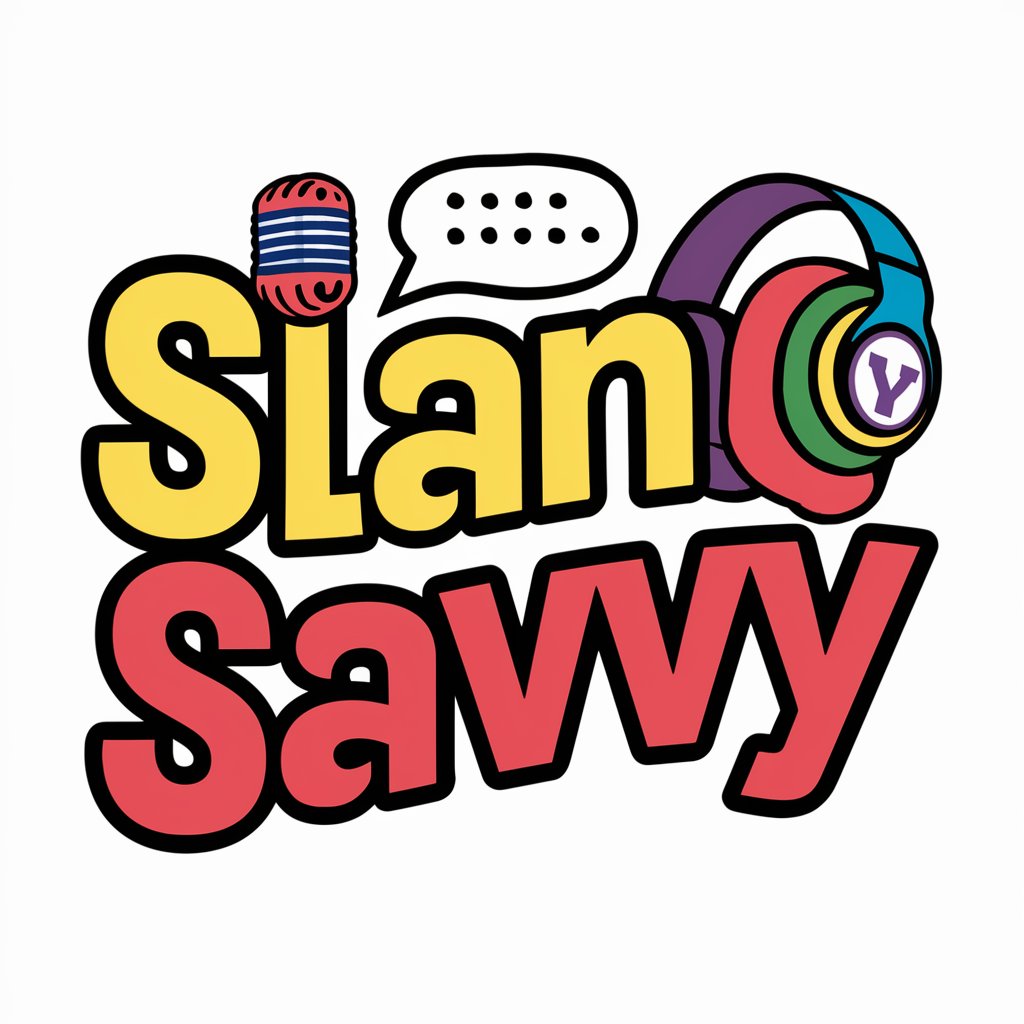
Slang Savvy-slang enhancement for your content.
AI-powered slang suggestions for any text.

Expert in everyday American English and slang, including subculture terms.
Explain this slang term:
What does this phrase mean in street slang?
How would a police officer use this term?
Can you provide the context for this slang?
Get Embed Code
Introduction to Slang Savvy
Slang Savvy is an innovative language understanding tool designed to help users decode, learn, and effectively use slang, idiomatic expressions, and colloquial language across various contexts. The service functions by providing definitions, usage examples, translations, and cultural background for both popular and niche slang terms, making it accessible to anyone looking to enhance their language comprehension or communication skills in informal settings. The design purpose of Slang Savvy is to bridge the gap between standard language and the evolving, dynamic lexicon used in everyday conversations. By leveraging both modern AI technology and a vast slang database, it enables users to stay current with ever-changing language trends. For example, when a user encounters a new term like 'ghosting' or 'lit' on social media, Slang Savvy will not only define the term but also give examples of how it is used in real life, along with its origins and variations in different regions or communities.
Main Functions of Slang Savvy
Slang Definition and Explanation
Example
'Flexing' - This term is commonly used to refer to showing off or boasting, often in a materialistic way, such as displaying expensive possessions.
Scenario
A user can input the term 'flexing' into Slang Savvy. The tool will provide a detailed definition, contextual examples like 'She was flexing her new watch all day at school,' and even provide a cultural insight into how the term might vary in different communities or regions.
Contextual Usage Examples
Example
'FOMO' (Fear of Missing Out) - A common slang in the context of social media, referring to anxiety about missing out on experiences.
Scenario
A user unsure about how to use 'FOMO' in a sentence might input it into Slang Savvy. The tool will offer multiple examples such as 'I couldn’t go to the party last night, and now I have major FOMO!' It may also show how different people use this term across platforms like Twitter or Instagram, indicating slight variations in tone or usage.
Slang Evolution Tracking
Example
'Bae' - Initially popularized as a term of endearment, it has evolved to be widely used as a casual shorthand for 'before anyone else.'
Scenario
A user might search for 'bae' in Slang Savvy and receive a timeline detailing its usage history, from its origins in social media to its mainstream adoption. The tool might include a map highlighting where it is most commonly used globally and which generations or subcultures are adopting it.
Translation of Slang Across Regions
Example
'Mate' vs. 'Buddy' - While 'mate' is common in the UK and Australia, 'buddy' is more commonly used in the US.
Scenario
A user from the US looking to understand British slang might type 'mate' into the tool. Slang Savvy would then explain the term and compare it to its American equivalent ('buddy'). It could also provide a small dialogue example to showcase the cultural nuance, such as a British person saying, 'Oi mate, how’s it going?'
Ideal Users of Slang Savvy
Social Media Enthusiasts
Users who engage with social media platforms like Twitter, Instagram, and TikTok regularly. These individuals are constantly exposed to new slang terms, memes, and internet culture. Slang Savvy provides them with the ability to quickly understand and stay updated on trending phrases. For example, a teenager who frequently uses TikTok can easily check the meaning of terms like 'sus' or 'slay' to ensure they are using them correctly in conversations.
Language Learners
People learning a second language or those who have mastered formal language and now seek to understand colloquial expressions. Slang Savvy is ideal for non-native speakers looking to improve their conversational skills by understanding real-world language usage. For instance, a Spanish learner studying in Spain could use Slang Savvy to understand regional slang and avoid awkwardness in social situations.
Content Creators and Influencers
Individuals who are involved in content creation on platforms like YouTube, Twitch, or podcasts, and need to understand or incorporate slang into their content for relatability. For instance, a YouTuber creating content for a younger audience could use Slang Savvy to learn the latest slang that resonates with their viewers, ensuring their language remains fresh and engaging.
Professional Communicators
People working in marketing, customer service, or any role that involves public-facing communication. These professionals benefit from knowing how to appropriately use or respond to slang in informal communications, emails, or advertising campaigns. For example, a marketing professional working on a youth-oriented campaign could use Slang Savvy to understand how the target demographic uses certain expressions, allowing them to craft more effective and relatable messaging.
How to UseSlang Savvy guide Slang Savvy
Visit aichatonline.org for a free trial without login, also no need for ChatGPT Plus.
Simply visit the website at aichatonline.org, where you can access Slang Savvy's features immediately. There's no need to log in or sign up to start using the tool, and you won't need a ChatGPT Plus subscription.
Enter text or a sentence.
Once you're on the platform, input the text or sentence you'd like to analyze or improve. You can do this by either typing directly into the interface or pasting pre-written content.
Select your language preference.
Choose the language you want the tool to analyze. Slang Savvy is capable of understanding and interpreting slang in multiple languages, ensuring accurate and contextually relevant suggestions.
Select the desired slang level.
You can opt for different slang intensity levels, such as light, medium, or heavy slang. This allows the tool to tailor suggestions based on your needs, whether you're aiming for casual or more edgy language.
Review and apply suggestions.
After the analysis, Slang Savvy will present various slang suggestions orHow to use Slang Savvy corrections for your text. You can either copy the results directly or tweak them to fit your needs before applying them.
Try other advanced and practical GPTs
Chem Solver
AI-powered chemical analysis at your fingertips

Bash Shell Script
Automate tasks with AI-powered Bash scripting

Creative Writing
AI-powered creativity, tailored to your writing.

CAE Simulation Expert-Ansys|Fluent|LS-DYNA|Abaqus
AI-powered CAE simulation and automation

Zen Co-Pilot by ty-gpt.com
AI-powered assistant that streamlines support workflows

Oferta Direta
AI-powered ad copy that converts

MTG EDH Deckmaster
AI-driven deck optimization for Commander players.

Copy Editor Bot - CE 101
AI-driven proofreading for flawless writing.

Advanced Microeconomics Tutor - Theory & Analytics
AI-powered microeconomics tutor for in-depth learning.

BTC-USDT Bitcoin Trend Prediction Oracle v.1.9
AI-driven Bitcoin trend forecasting tool

Whiteboard Animation Creator
Create AI-powered whiteboard animations effortlessly

DotNet Senior Developer (C#)
AI-powered C# development assistant.

- Social Media
- Marketing Materials
- Creative Content
- Casual Writing
- Informal Blogs
Frequently Asked Questions about Slang Savvy
What is Slang Savvy?
Slang Savvy is an AI-powered tool designed to enhance your writing by interpreting and suggesting slang expressions. It helps users incorporate casual, trendy, or regional language into their content for a more relatable, engaging tone.
Can Slang Savvy handle different languages?
Yes, Slang Savvy supports multiple languages and understands both regional slang and global slang variations. You can switch between languages as needed to ensure your text resonates with your intended audience.
Is Slang Savvy suitable for professional writing?
Slang Savvy is primarily designed for casual, conversational writing, such as social media posts, marketing materials, and informal blog content. While it can offer suggestions for some professional contexts, it’s best suited for light-hearted and creative works.
Do I need a subscription to use Slang Savvy?
No, you don’t need any subscription or login to start using Slang Savvy. You can access the tool for free directly from the website, with no limitations or paywalls during your free trial period.
Can I adjust the intensity of slang in my writing?
Yes, Slang Savvy allows you to choose the intensity level of slang in your text. You can select from light, medium, or heavy slang, depending on how informal or trendy you want your content to sound.





